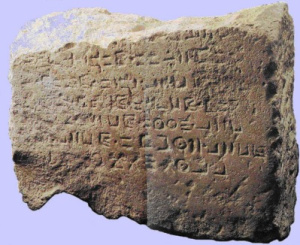Introduction
 |
| Tamazgha (North Africa) |
Archaeological remains dating as far back as 7000 BC show that Tamazight (or Berbers Language) speaking peoples originally inhabited the region ranging from Siwa oasis (western Egypt) on the east all the way to the Canary Islands (Atlantic coast) of northwest Africa on the west, and and from the Mediterranean coast on the north to just below the Sahara Desert on the south.
The Berbers live in scattered communities across what is today : Morocco, Algeria, Tunisia, Libya, Egypt, Mali, Burkina Faso, Niger, Senegal and Mauretania. The nation of Senegal takes its name from a Berber-speaking group, the Zenaga, who live in an area of southwestern Mauritania.
From early on, various parts of this region were also settled by a series of newly arriving populations. The most important of these were the Romans, who ruled for seven centuries (146 b.c.–439 a.d.); the Byzantines (533–647); the Turks, who reached as far as presentday Tunisia and Algeria (1515–1830) during the expansion of the Ottoman Empire; and most recently, the French (1830–1962 in Algeria; 1881–1956 in Tunisia;1912–1955 in Morocco).
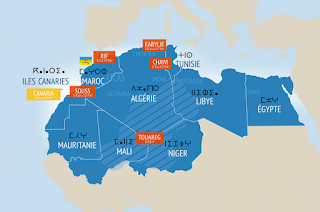 |
| Tamazgha |
Prehistory
Western North Africa (Tamazgha) on the whole is believed to have been inhabited by Berbers from at least 10,000 BC. Northern African cave paintings, dating back 9–10 millennia, have been found in the Tassili n'Ajjer region of southern Algeria.
Others were found in Tadrart Acacus in the Libyan desert. A Neolithic society, marked by domestication and subsistence agriculture, developed in the Saharan and Mediterranean region of northern Africa between 6000 BC and 2000 BC.
This type of life, richly depicted in the Tassili n'Ajjer cave paintings of south-eastern Algeria, predominated in the north africa until the classical period. Prehistorical Tifinagh scripts were also found in the Oran region of Algeria.
During the pre-Roman era, several successive independent states (Massylii) existed before the king Masinissa unified the people of Numidia.
 |
| Tassili n'Ajjer painting |
 |
| Tadrart Acacus painting |
 |
| Hoggar painting |
History
In historical times, the Berbers expanded south into the Sahara (displacing earlier populations such as the Azer and Bafour). However much of Berber culture is still celebrated among the cultural elite in Morocco, and Algeria.
The areas of North Africa that have retained the Berber language(Tamazight) and traditions best have been, in general, Morocco and the highlands of Algeria (Kabylie, Aures et cetera), most of which in Roman and Ottoman times remained largely independent. The Ottomans did penetrate the Kabylie area; Turkish influence can be seen in food, clothes and music, and to places the Phoenicians never penetrated, far beyond the coast. These areas have been affected by some of the many invasions of North Africa, most recently that of the French.
A chronology of some historical events in the Berber area:
7000 BC - Capsian civilization; emergence of proto-Mediterranean peoples, ancestors of the Berbers.
6000-2000 BC - Neolithic period in the North Africa and the Sahara desert.
3300 BC - First Egyptian references to the people who are now called Berber
1100 BC - Phoenicians establish trade centers
814 BC - Carthage is founded
500-400 BC - Formation of Berber Kingdoms: Mauritania in the west, Massaessyles in the center, and Massyles in the east.
146 BC - Romans destroy Carthage and establish the province Mauritania Tingitana (the origin of the word Moor) in North Africa/Tamazgha -- Morocco, Algeria, Tunisia and Libya --
ca 200 - Berbers become Christians
ca 350 - North Africa/Tamazgha -- Morocco, Algeria, Tunisia and Libya -- becomes a hotbed for "heretic" Christian cults in the Christian Roman Empire
ca 400 - St. Augustine
429 - Vandals invade North Africa/Tamazgha -- Morocco, Algeria, Tunisia and Libya --
533 - Byzantine Empire drives out the Vandals and takes control - religious conflicts between Berber Christian "heretics" and Byzantine church
674-700 - Muslims drive out the Byzantines and conquer North Africa/Tamazgha -- Morocco, Algeria, Tunisia and Libya.
711-713 - Spain conquered by Muslims and Berbers. Al-Andalus established in Spain
1085-1258 - Berber Almoravid and Almohad dynasties rule Al-Andalus and North Africa/Tamazgha -- Morocco, Algeria, Tunisia and Libya --
1492 - Moors driven out of Al-Andalus
1900 - French and Spanish colonial aspirations in North Africa/Tamazgha -- Morocco, Algeria, Tunisia and Libya --, leading to colonization
1956-1963 - Independence for North Africa/Tamazgha -- Morocco, Algeria, Tunisia and Libya -- states
Origins
Around 5000 BC, the populations of North Africa were primarily descended from the makers of the Iberomaurusian and Capsian cultures, with a more recent intrusion associated with the Neolithic revolution.The proto-Berber tribes evolved from these prehistoric communities during the Late Bronze to Early Iron Age.
The Berbers have lived in North Africa for thousands of years and their presence has been recorded as early as 3000 B.C.E. Greeks, Romans, and ancient Egyptians have indicated the presence of Berbers in their records. The Berbers are known from Pharaonic antiquity under the names of Lebu, Tehenu, Temehu or Meshwesh. They formed tribes, but also the ancestral realms as Numidia with his Gaia kings, Syphax, Massinissa, Juba I and Juba II. It was they who were also behind the creation of ancient Libya, and the kings of XXII and XXIII Egyptian dynasties were also Berber.
 |
| Ancient Libu Libyan. Bronze inlaid with gold and silver, during the reign of Rameses II, Louvre Museum |
 |
| The main sites of the Iberomaurusian and Capsian cultures in north Africa |
Numidia
 |
| Map of Numidia 230 BC |
Numidia (202 – 46 BC) was an ancient Berber kingdom in modern Algeria and part of Tunisia that later alternated between being a Roman province and being a Roman client state. It was located on the eastern border of modern Algeria, bordered by the Roman province of Mauretania (in modern Algeria and Morocco) to the west, the Roman province of Africa (modern Tunisia) to the east, the Mediterranean to the north, and the Sahara Desert to the south. Its people were the Numidians.
The name Numidia was first applied by Polybius and other historians during the third century BC to indicate the territory west of Carthage, including the entire north of Algeria as far as the river Mulucha (Muluya), about 160 kilometres (100 mi) west of Oran. The Numidians were conceived of as two great groups: the Massylii in eastern Numidia, and the Masaesyli in the west. During the first part of the Second Punic War, the eastern Massylii under their king Gala were allied with Carthage, while the western Masaesyli under king Syphax were allied with Rome.
 |
| Masinissa (c.240-148), King of Numidia, Berber & Roman script |
In 206 BC, the new king of the eastern Massylii, Masinissa, allied himself with Rome, and Syphax of the Masaesyli switched his allegiance to the Carthaginian side. At the end of the war, the victorious Romans gave all of Numidia to Masinissa of the Massylii. At the time of his death in 148 BC, Masinissa's territory extended from Mauretania to the boundary of the Carthaginian territory, and also south-east as far as Cyrenaica, so that Numidia entirely surrounded Carthage (Appian, Punica, 106) except towards the sea.
Masinissa was succeeded by his son Micipsa. When Micipsa died in 118 BC, he was succeeded jointly by his two sons Hiempsal I and Adherbal and Masinissa's illegitimate grandson, Jugurtha, of Berber origin, who was very popular among the Numidians. Hiempsal and Jugurtha quarreled immediately after the death of Micipsa. Jugurtha had Hiempsal killed, which led to open war with Adherbal.
After Jugurtha defeated him in open battle, Adherbal fled to Rome for help. The Roman officials, allegedly due to bribes but perhaps more likely because of a desire to quickly end conflict in a profitable client kingdom, settled the fight by dividing Numidia into two parts. Jugurtha was assigned the western half. However, soon after conflict broke out again, leading to the Jugurthine War between Rome and Numidia.
Mauretania
In antiquity, Mauretania was an independent Berber kingdom under King Bocchus I (110-80 BC). It was situated on the Mediterranean coast of North Africa, in modern western Algeria and northern Morocco.
Berber Languages
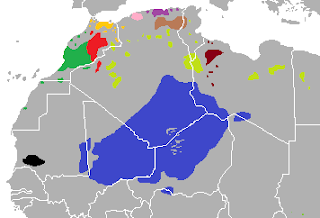 |
| Areas in North Africa where Berber languages are spoken |
They are spoken by around 30 to 40 million people in Northern Africa throughout the Mediterranean coast, the Sahara desert and Sahel, an area which is dominated by Berbers in origin. These Berber speakers are mainly concentrated in Morocco and Algeria, followed by Mali, Niger and Libya. Smaller Berber-speaking communities are also found as far east as Egypt, with a southwestern limit at Burkina Faso.
The Berber languages comprise many closely related varieties. Among these idioms are Riff, Kabyle, Shilha, Siwa, Zenaga, Sanhaja, Tazayit and Tamasheq, as well as the ancient Guanche language.
 |
| Tifinagh Alphabet (Berber Languages) |
Contemporary demographics
Regarding the remaining populations that speak a Berber language in the north Africa, they account from 50% to 60% of the Moroccan population and from 15% to 35% of the Algerian population, besides smaller communities in Libya and Tunisia and very small groups in Egypt and Mauritania. The Tuareg in Mali, Niger and Burkina Faso number some 850,000, 1,620,000 and 50,000 respectively although Tuaregs are Berber people with a traditionally nomadic pastoralist lifestyle. They are the principal inhabitants of the vast Sahara Desert.
 |
| Berber populations in North Africa |
Regions with significant populations :
Morocco : From 13 million to 20 million
Algeria : From 9 to 13 million
France : more than 2 million
Niger : 1,620,000
Mali : 850,000
Libya : 600,000
Mauritania : 114,000
Tunisia : 110,000
Burkina Faso : 50,000
Egypt : 34,000
Canada : 25,885
Israel : 3,500
Total Berbers population : From 25 to 38 million
Culture
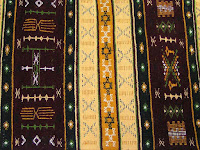 |
| Berber carpet |
The Berber tribes traditionally weave kilims. The tapestry maintains the traditional appearance and distinctiveness of the region of origin of each tribe, which has in effect its own repertoire of drawings. The textile of plain weave is represented by a wide variety of stripes, and more rarely by geometrical patterns such as triangles and diamonds. Additional decorations such as sequins or fringes, are typical of Berber weave in Morocco. The nomadic and semi-nomadic lifestyle of the Berbers is very suitable for weaving kilims. The customs and traditions differ from one region to another.
The social structure of the Berbers is tribal. A leader is appointed to command the tribe. In the Middle Ages, many women had the power to govern, such as Kahina and Tazoughert Fatma in Aurès, Tin Hinan in Hoggar, Chemci in Aït Iraten, Fatma Tazoughert in the Aures. Lalla Fatma N'Soumer was a Berber woman in Kabylie who fought against the French.
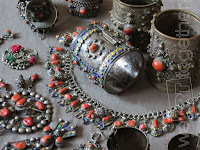 |
| Kabyle jewels |
In marriages, the man selects the woman, and depending on the tribe, the family often makes the decision. In comparison, in the Tuareg culture, the woman chooses her future husband. The rites of marriage are different for each tribe. Families are either patriarchal or matriarchal, according to the tribe.
Berber flag
 |
| Berber Flag |
In the 1970s the Berber Academy (Agraw Imazighen) proposed the first Berber flag. In 1998 the World Amazigh Congress made the flag official at Tafira on Las Palmas in the Canary Islands, which were formerly inhabited by the Guanches, an ancient Berber people.
The Berbers flag is composed of blue, green, and yellow horizontal bands of the same height, and a Tifinagh letter yaz or aza.
Each colour corresponds to an aspect of Tamazgha, the territory inhabited by Berbers in North Africa:
Blue represents the Mediterranean Sea and the Atlantic Ocean;
Green represents nature and the green mountains;
Yellow represents the sands of the Sahara Desert.
The yaz symbolizes the "free man", which is the meaning of the Berber word amazigh, the Berbers' own name for themselves (endonym). It is in red, the colour of life, and also the colour of resistance.
The Berber flag thus symbolizes the entire Amazigh people, living in harmony with their land, Tamazgha (North Africa).
References
- https://en.wikipedia.org/wiki/Berbers
- http://phoenicia.org/berber.html
- http://www.britannica.com/topic/Berber
- http://www.newworldencyclopedia.org/entry/Berber
- http://www.encyclopedia.com/topic/Berbers.aspx
- https://www.temehu.com/imazighen/berbers.htm
- https://en.wikipedia.org/wiki/Berber_flag
- http://www.axl.cefan.ulaval.ca/afrique/berberes_Afrique.htm
- http://minorityrights.org/minorities/berber/
- https://www.cia.gov/library/publications/the-world-factbook/fields/2075.html
- https://www.cia.gov/library/publications/the-world-factbook/geos/ml.html
- https://www.cia.gov/library/publications/the-world-factbook/geos/ng.html
- http://news.bbc.co.uk/2/hi/africa/6982266.stm
- http://africa.si.edu/exhibits/tuareg/who.html
- http://howafrica.com/the-berbers-the-origins-of-an-ancient-people/
- The Berber Identity Movement and the Challenge to North African States - Bruce Maddy-Weitzman
- Linguistic and archaeological evidence for Berber prehistory - Roger Blench
- Berber Culture on the World Stage - Jane E. Goodman
- What is Berber ? : Characterizations of Imazighen from Britain and Morocco - Byron Head
- Historical Dictionary of the Berbers (Imazighen) - Hsain Ilahiane
- Histoire de l'émigration kabyle en France au XXe - Karina Slimani-Direche
- Les cultures du Maghreb - Maria Angels Roque, Paul Balta, Mohammed Arkoun
- Dialogues d'histoire ancienne à l'Université de Besançon - Centre de recherches d'histoire ancienne
- General history of Africa, Ancient Civilizations of Africa (UNESCO 1990) - J. Desanges
- História da Africa. Anterior aos descobrimentos - Mario Curtis Giordani
- ABC Amazigh. An editorial experience in Algeria, 1996–2001 experience - Smaïl Medjeber
